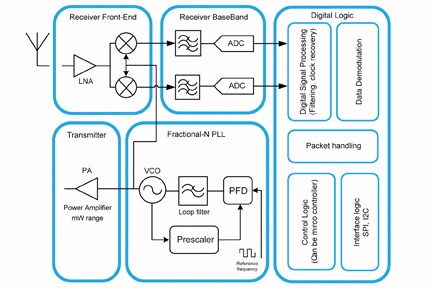Author:
Reported by Cliff Keys, Editorial Director, Editor-in-Chief, Power Systems Design
Date
11/30/2010
Shortlink is a development company specialising in the field of low-power portable electronics and wireless communications. Highly competent in both ASIC and electronic design, Shortlink helps cut the development time of customers' projects and is able to offer complete system solutions. The company is strongly focused on contract development, in most cases working on a very long-term basis with companies that are market leaders in their respective business areas. Low power consumption has been Shortlink's hallmark since its formation. Shortlink AB and Landshut Silicon Foundry GmbH today announced a partnership agreement to provide Shortlink low power RF and mixed-signal custom IP in LFoundry's industry leading LF150 modular 150nm CMOS process technology. The move will enable LFoundry to provide ASIC developer customers with a proven source of low power RF and mixed-signal IP that can be quickly adapted to meet specific application requirements. The Shortlink IP offering will include SRD transceivers, RF receivers and transmitters, PLL, VCO, ADC, DAC and amplifiers. The two companies have long collaborated on ASIC design and manufacture, with Shortlink currently making use of the LF150 process for wireless building security and audio communication projects.

Hans-Erik Backram, Shortlink CEO said, "Demand for low power wireless connectivity and energy harvesting solutions is accelerating fast, ASIC developers though often want to leave the RF and mixed signal side to a trusted third party in order to focus on their own core competences. Our cooperation with LFoundry provides us with a new channel to market that harnesses an industry leading process capable of delivering the outstanding RF and low power performance that's needed to support cutting edge design." Michael Lehnert, LFoundry CEO said, "The partnership with Shortlink will mean our customers can access an even greater source of unique IP, that helps avoid the cost of prolonged in-house development. There's tremendous synergy between Shortlink's low power RF and mixed signal design skills and the versatility and performance capabilities of our 150nm low power CMOS process. This can only enhance energy sensitive product design and further reduce time to market." Ultra Low Power RF Transceiver added to ASIC Building Block Portfolio Shortlink announced today the introduction of an ultra low power RF transceiver to its growing ASIC building block portfolio. Consuming just 8mA, the transceiver is the first variant in a family of customisable transceivers and uses less than 50% of the power of typical discrete RF modules or transceiver ICs. The move reflects increasing demand from designers of miniature battery powered wireless products for compact, high-efficiency ASIC solutions, capable of significantly extending the operating times achievable from a single coin cell source. Designed to support the 868MHz and 915MHz ISM (industrial, scientific and medical) bands, the transceiver building block can also be readily adapted to suit 315MHz, 433MHz and 2.4GHz bands. Transceiver sensitivity is -110dBm and maximum output power a generous 10dBm. The transceiver handles short-range line-of-sight communication up to a range of 1km and is ideal in whole building environments, where wall and floor penetration is essential. Applications include body-worn medical sensors, miniature wireless audio communication devices, wireless sensors, building automation and security systems and a host of new equipment reliant on energy harvesting power supplies. Based on a low IF architecture, the Shortlink transceiver has been developed, fully tested and proven on a well characterised 150nm CMOS process, and is easily integrated with Shortlink's low overhead proprietary radio protocols and low power mixed-signal function blocks to arrive at a complete system on silicon solution in a minimum timescale. Hans-Erik Backram, Managing Director of Shortlink said, "By providing our low power RF transceiver as a customisable ASIC building block, based on a mature process technology, we aim to help customers remove significant NRE and effectively de-risk new wireless product developments." "We have proven time and time again that an ASIC building block approach can reduce power, cost and time to market and by its nature, can also guard against product counterfeiting, a further key consideration in highly competitive product markets." www.shortlink.se